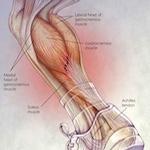
New research gives clues as to why older athletes get more tendon injuries
21 April 2015, 2:30PM
Will Hoyles
New research into how tendons age has found that the material between tendon fibre bundles stiffens as it gets older and that this is responsible for older athletes being more susceptible to tendon injuries.
Researchers from Queen Mary University of London (QMUL), University of East Anglia, University College London and University of Liverpool, repeatedly stretched samples of horse tendons, which are very similar to human ones, to test their elasticity and ability to recover.
Experiments in the past have shown that stiffening in aging tendons contributes to increased injuries in older tendons and this new research shows that it is specifically the stiffening and decreased resistance to repetitive loading of the tissue which holds tendon fibre bundles in place that is responsible.
Tendon fibre bundles are surrounded by the interfascicular matrix (IFM), made up of tissue which enables the fibre bundles to slide past each other and stretch independently. In horses, the superficial digital flexor tendon (SDFT), which is used to store energy for propulsion, requires greater stretching of the IFM, than in the common digital extensor tendon (CDET) which aids the positioning of the leg.
While the IFM is more elastic, recovering better after loading in the SDFT it is prone to injury in older age because of the greater strain it is put under, and the stiffening and decreased ability to recover that results. The SDFT is very similar to the human Achilles tendon and so the results of this study can be directly applied to Achilles injury in athletes.
This new discovery implies that injuries to different tendons could be treated differently and that new treatments could be developed to prevent injuries in older athletes.
Dr Chavaunne Thorpe, from QMUL’s School of Engineering and Materials Science, said:
“We now have a much greater understanding of what happens tendon structure as athletes get older and the role that plays in injuries.
“This information could be used to develop measures to reduce the risk of tendon injury or to speed recovery.”
Bibliographical information - Thorpe, C., Godinho, M., Riley, G., Birch, H., Clegg, P. and Screen, H. (2015). The interfascicular matrix enables fascicle sliding and recovery in tendon, and behaves more elastically in energy storing tendons. Journal of the Mechanical Behavior of Biomedical Materials.
The full report can be found at - http://www.sciencedirect.com/science/article/pii/S1751616115001290
Queen Mary University of London (QMUL) is one of the UK’s leading universities, and one of the largest institutions in the University of London, with 20,260 students from more than 150 countries.
A member of the Russell Group, we work across the humanities and social sciences, medicine and dentistry, and science and engineering, with inspirational teaching directly informed by our research - in the most recent national assessment of the quality of research, we were placed ninth in the UK (REF 2014).
We also offer something no other university can: a stunning self-contained residential campus in London’s East End. As well as our home at Mile End, we have campuses at Whitechapel, Charterhouse Square and West Smithfield dedicated to the study of medicine, and a base for legal studies at Lincoln’s Inn Fields.
We have a rich history in London with roots in Europe’s first public hospital, St Barts; England’s first medical school, The London; one of the first colleges to provide higher education to women, Westfield College; and the Victorian philanthropic project, the People’s Palace at Mile End.
Today, as well as retaining these close connections to our local community, we are known for our international activities, and have research and teaching partnerships with leading universities around the world. This includes two very successful and long-standing joint partnerships with the Beijing University of Posts and Telecommunications, and Nanchang University.
QMUL has an annual turnover of £350m, a research income worth £100m, and generates employment and output worth £700m to the UK economy each year.
